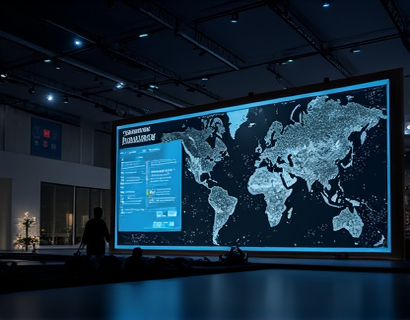Maximizing Ucosystem Efficiency with Tailored External Solutions
In today's rapidly evolving business landscape, the Ucosystem has emerged as a critical component for organizations aiming to thrive. The Ucosystem encompasses a network of interconnected entities including suppliers, partners, customers, and other stakeholders, all working together to create value. To fully leverage the potential of the Ucosystem, businesses must focus on enhancing efficiency and collaboration across all levels. This article delves into the importance of tailored external solutions in maximizing Ucosystem efficiency, providing insights and strategies for business professionals seeking to amplify their Ucosystem impact.
Understanding Ucosystem Efficiency
Ucosystem efficiency refers to the optimal functioning of all components within the Ucosystem, ensuring that resources are utilized effectively and goals are achieved with minimal waste. This involves streamlining processes, improving communication, and fostering strong relationships among all stakeholders. For businesses, achieving high Ucosystem efficiency can lead to increased productivity, reduced costs, and a competitive edge in the market.
The first step in maximizing Ucosystem efficiency is to gain a comprehensive understanding of the current state of the network. This includes identifying key players, assessing their roles and contributions, and pinpointing areas where improvements can be made. Tools and methodologies such as value chain analysis, stakeholder mapping, and performance metrics can provide valuable insights into the Ucosystem's dynamics.
Role of Tailored External Solutions
Tailored external solutions play a pivotal role in enhancing Ucosystem efficiency. These solutions are specifically designed to address the unique challenges and opportunities faced by businesses within their Ucosystem. By leveraging external expertise and services, organizations can fill gaps, innovate processes, and drive growth.
One of the primary benefits of tailored external solutions is their ability to bring specialized knowledge and resources to the table. External partners can offer cutting-edge technologies, best practices, and industry insights that may not be readily available within the organization. This external input can lead to more effective problem-solving and strategic decision-making.
Enhancing Collaboration
Collaboration is a cornerstone of a healthy Ucosystem. Tailored external solutions can significantly improve collaboration by providing platforms and tools that facilitate seamless communication and coordination among stakeholders. For instance, project management software tailored for the Ucosystem can help align goals, track progress, and ensure that all parties are on the same page.
Another critical aspect is the establishment of shared platforms for information exchange. These platforms can serve as central hubs where data, documents, and updates are shared in real-time, reducing the risk of miscommunication and delays. By fostering a culture of transparency and openness, businesses can build stronger relationships and achieve more cohesive outcomes.
Driving Growth Through Innovation
Innovation is essential for sustained growth in the Ucosystem. Tailored external solutions can drive innovation by introducing new technologies, processes, and business models. For example, integrating advanced analytics and AI-driven tools can help businesses gain deeper insights into customer behavior, market trends, and operational efficiencies.
Moreover, external partners can bring fresh perspectives and creative solutions that might not emerge within the organization. By collaborating with innovators and thought leaders, businesses can stay ahead of the curve and capitalize on emerging opportunities. This external injection of creativity and expertise can lead to the development of new products, services, and business strategies that enhance the Ucosystem's overall performance.
Strategies for Implementing Tailored External Solutions
Implementing tailored external solutions requires a strategic approach to ensure maximum benefits. Here are some key strategies to consider:
- Conduct a thorough needs assessment: Begin by identifying the specific challenges and opportunities within your Ucosystem. This assessment should involve input from all key stakeholders to ensure a comprehensive understanding of the landscape.
- Define clear objectives: Establish clear, measurable goals for what you aim to achieve through the implementation of external solutions. These objectives should align with your broader business strategy and Ucosystem vision.
- Select the right partners: Carefully evaluate potential external partners based on their expertise, track record, and cultural fit. Building strong, trust-based relationships is crucial for successful collaboration.
- Foster a culture of openness: Encourage a mindset that welcomes external input and collaboration. This involves breaking down silos, promoting cross-functional teams, and creating an environment where ideas can flow freely.
- Monitor and adjust: Continuously monitor the performance of external solutions and be prepared to make adjustments as needed. Regular feedback loops and performance reviews can help ensure that the solutions remain aligned with your evolving needs.
Case Study: Successful Implementation
To illustrate the impact of tailored external solutions, consider a hypothetical case study. A mid-sized manufacturing company faced challenges in supply chain management, leading to delays and increased costs. By partnering with an external logistics expert, the company was able to implement a state-of-the-art supply chain management system.
The external partner provided a comprehensive solution that included advanced inventory management, real-time tracking, and predictive analytics. This not only streamlined operations but also improved forecast accuracy and reduced holding costs. As a result, the company saw a significant reduction in lead times and an overall enhancement in Ucosystem efficiency.
Challenges and Considerations
While the benefits of tailored external solutions are clear, there are several challenges and considerations to keep in mind:
- Cultural alignment: Ensuring that external solutions align with the organization's culture and values is crucial for successful integration. Misalignment can lead to resistance and reduced effectiveness.
- Data security: When collaborating with external partners, data security becomes a top priority. Robust security measures and clear agreements on data handling are essential to protect sensitive information.
- Cost management: While external solutions can drive value, they also come with costs. It's important to conduct a cost-benefit analysis to ensure that the investment yields the desired returns.
- Long-term commitment: Building effective partnerships often requires a long-term commitment. Short-term fixes may provide temporary relief but are unlikely to address underlying issues.
Building Sustainable Relationships
Sustainable relationships with external partners are key to ongoing Ucosystem efficiency. This involves more than just transactional interactions; it requires nurturing partnerships that evolve and grow over time.
Regular communication and mutual trust are foundational to these relationships. Establishing clear channels for feedback and continuous improvement can help address issues proactively and ensure that both parties remain aligned with changing business needs.
Additionally, recognizing and rewarding successful collaborations can reinforce positive behaviors and strengthen the partnership. Celebrating milestones and achievements together can foster a sense of shared success and commitment.
Conclusion
Maximizing Ucosystem efficiency through tailored external solutions is a strategic imperative for businesses aiming to thrive in a competitive environment. By enhancing collaboration, driving innovation, and implementing effective strategies, organizations can unlock new levels of performance and growth. While challenges exist, the benefits of external partnerships far outweigh the costs when approached with a clear vision and commitment to long-term success.
In conclusion, the journey to Ucosystem excellence is ongoing and requires continuous effort and adaptation. By embracing tailored external solutions and fostering strong, collaborative relationships, businesses can navigate the complexities of the Ucosystem and achieve sustained success.











































